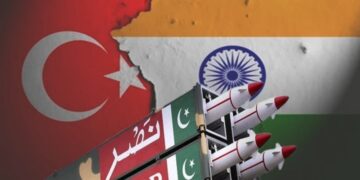Ukrainian President Volodymyr Zelenskyy, warned of an impending escalation in Russia’s offensive in the northeast, highlighting a significant deficiency in Ukraine’s air defense capabilities. Zelenskyy emphasized that Kyiv possesses merely a quarter of the air defenses required to maintain its front line.
The warning comes in the wake of a surprise Russian assault in the Kharkiv region on May 10, marking their most substantial territorial gains in 18 months. Russian forces advanced between five and ten kilometers along the northeastern border before being halted by Ukrainian troops. Zelenskyy suggested that this incursion could be the precursor to a broader offensive. “I won’t say it’s a great success for Russia, but we have to be sober and understand that they are going deeper into our territory,” he remarked, speaking from Kyiv in his first interview with foreign media since the offensive began.
While Zelenskyy described the situation in the Kharkiv region as “controlled,” he admitted it was “not stabilized.” He reiterated urgent calls for allies to provide more air defenses and fighter jets to counter Russia’s air superiority as the conflict extends into its third year. “Today, we have about 25 percent of what we need to defend Ukraine. I’m talking about air defense,” Zelenskyy stated.
To achieve air parity with Russia, Ukraine needs “120 to 130” F-16 fighter jets or other advanced aircraft, Zelenskyy asserted.
Kharkiv Offensive
Russian President Vladimir Putin, during a visit to China this week, claimed the northeastern offensive was in retaliation for Ukraine’s shelling of border regions and aimed to establish a “security zone.” Between May 9 and 15, Russian forces have captured 278 square kilometers, the most significant gain since late 2022, according to AFP’s analysis of data from the Institute for the Study of War (ISW). Moscow’s defense ministry reported that its forces have taken 12 villages in the Kharkiv region.
Ukraine has evacuated nearly 9,000 people from the northeast border area since the Russian assault began. Despite these gains, Putin stated there is no current intention to capture Kharkiv, Ukraine’s second-largest city, located about 30 kilometers from the border. The city remains home to over a million residents.
However, Oleg Synegubov, the Ukrainian governor of Kharkiv, cautioned that Russia was advancing near Lukyantsi, a village approximately 20 kilometers northeast of Kharkiv city. Ukrainian troops have been pulled back from that area under heavy fire, with reinforcements sent in.
Military analysts suggest the northeastern offensive may be intended to further stretch Ukrainian resources, with Russia exploiting its manpower and ammunition advantages. Ukraine’s army chief, Oleksandr Syrsky, indicated that Russia aims to force Ukraine to deploy more troops from its reserves.
“We realize that there will be heavy fighting ahead, and the enemy is preparing for it,” Syrsky said. As he braces for a wider Russian offensive, Zelenskyy acknowledged challenges with staffing and morale within Ukraine’s often outgunned and outnumbered forces.
“We need to staff the reserves… A large number of brigades are empty,” Zelenskyy told AFP. With no end to the war in sight, Ukraine’s military faces difficulties in recruitment, while troops grow exhausted and frustrated by the lack of rotation. Many Ukrainian soldiers have been on continuous duty for over two years without discharge.
In response to these challenges, a controversial new mobilization law effective Saturday lowers the draft age from 27 to 25 and imposes stricter penalties for draft evasion. However, a proposal to allow soldiers who have served more than 36 months to be discharged was scrapped by lawmakers.

















Comments